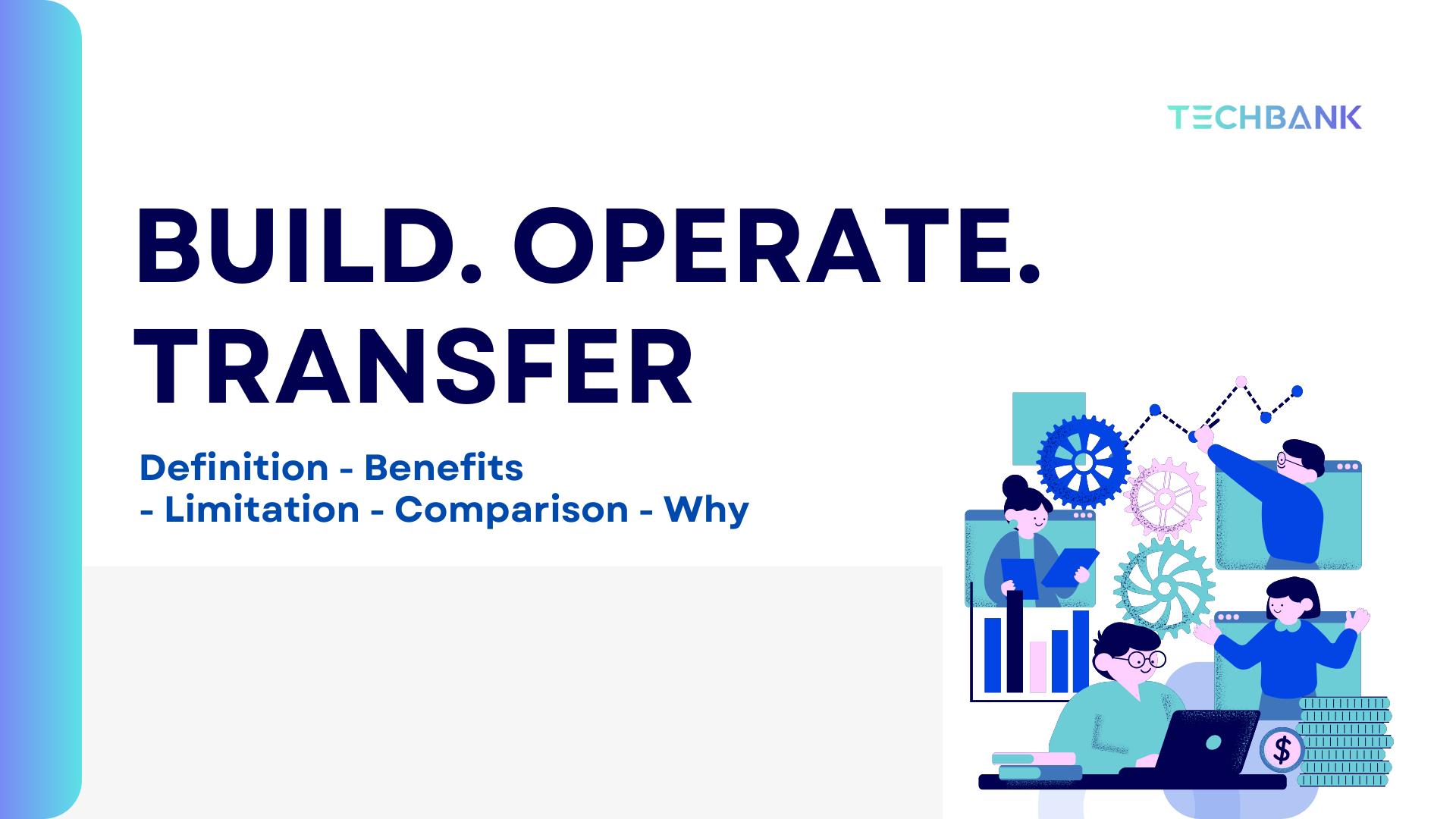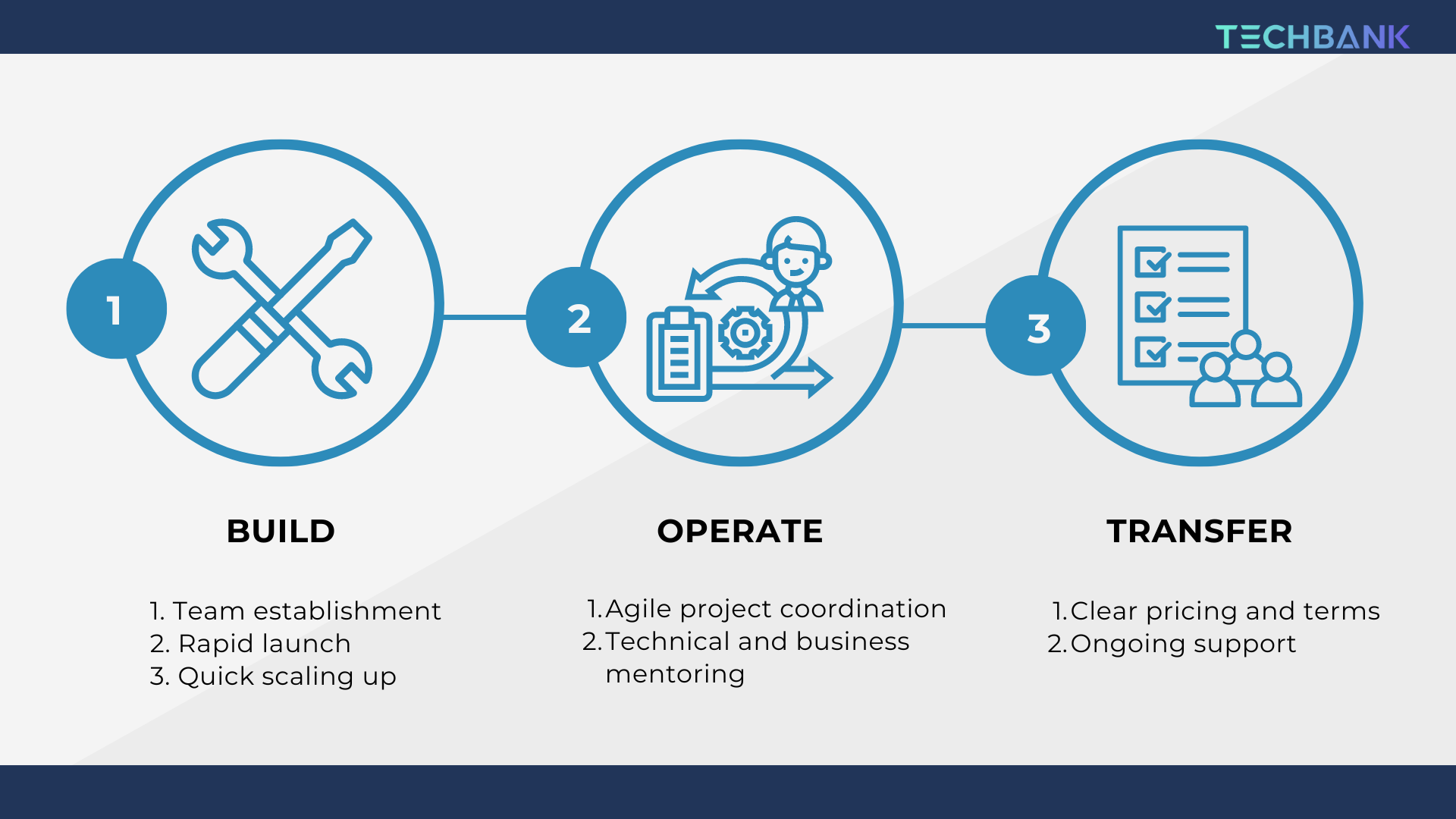
Imagine your organization hires a service provider to set up and run software development for you, and then hands it over once it’s ready. That’s BOT.
The Build-Operate-Transfer (BOT) model is great for companies looking to grow or enter new markets. This approach allows you to leverage the expertise, resources, and funding of specialized partners to manage different project stages. By working together, companies can handle complex projects more easily, drive growth, reduce risks, and increase efficiency.
Build-Operate-Transfer Model Definition
Build-Operate-Transfer (BOT) is when an organization hires a company to set up, improve, and manage software development before eventually taking it over themselves.
The model involves a company setting up and running a project, then handing it over to the hiring organization. This approach is a mix of insourcing and outsourcing, ideal for quickly developing new products or teams, especially in unfamiliar areas. Once the contract ends, the hiring company gains full ownership of the product, infrastructure, and staff. BOT is well-suited for projects like website or mobile app development.
3 Phases of the BOT Model
The build-operate-transfer (BOT) model consists of a three-phase software lifecycle tailored for large-scale projects. Here’s an overview of the three stages in the BOT model:
Construction (Build)
At this stage, the vendor builds and organizes the team, ensuring it is prepared to operate according to local regulations and has back-office support in areas such as HR and finance. Both parties agree on the rules and scope of the collaboration. The vendor carefully reviews standards to identify the skills and expertise needed for the new team.
The project then moves on to sourcing the right technologies, team members, office space, and tools based on the client’s needs.
The key steps in the building phase include:
- Establishing partnership rules: Define guidelines to ensure smooth cooperation and customize the BOT model to fit the client’s needs. The project’s cost should also be clearly communicated to the client.
- Recruitment: IT consultancy firms often recruit heavily for BOT projects, leveraging their knowledge of local employment laws to quickly find and hire the best talent.
- Office setup: The vendor selects the right location and sets up necessary infrastructure like internet, servers, workstations, software, and security measures.
- Legal activities: If requested by the client, the vendor establishes a subsidiary and handles all legal requirements. A separate office may also be set up if needed.
- Knowledge sharing and training: The vendor and client work together to train the team on company culture, processes, technical requirements, and business objectives.
Operation (Operate)
At this stage, the provider focuses on managing the offshore team in close collaboration with the client, ensuring the team is fully integrated and aligned with the client’s goals.
The provider works closely with the team to ensure all key processes are properly coordinated. The client also allocates time and resources for team training, which may include seminars and individual meetings.
The process involves ongoing system maintenance, ensuring uptime, performing security updates, and providing user support as agreed. Clients also set key performance indicators (KPIs) to monitor service quality, security, and compliance with the agreed service levels.
Transfer (Ownership Transfer)
At this stage, ownership is transferred. The provider hands over all project details and the team to the client at the end of the project or when the contract expires.
A transfer team manages:
- Shifting assets, processes, and staff to the client.
- Charging a one-time fee to relinquish employer rights.
- Moving office space and equipment.
- Transferring intellectual property and knowledge.
- Returning all procedures and departments to the client.
Sometimes, staff sign new contracts or a subsidiary is created for the client. After the transfer, the client’s operations team takes over.
The transfer phase often continues the commercial relationship. Providers may offer ongoing services. The transfer fee, usually 20-30%, is part of the contract and often included in the annual fee.

Advantages and Disadvantages of the BOT Model
Advantages
- Cost Savings: BOT helps companies cut costs by avoiding the expenses of setting up offices and hiring staff, especially useful for international expansion.
- Global Talent Access: BOT provides access to skilled professionals worldwide, with the provider setting up IT operations, hiring staff, and handling legal requirements, while also offering 24/7 support.
- Overhead Reduction: The provider takes care of IT management and administrative tasks, eliminating the need for office space and utility arrangements.
- Experienced Team: The client receives a well-trained IT team that has been with the provider from the beginning, already familiar with the client’s requirements and systems.
- Risk Mitigation: BOT reduces development risks by having the provider manage project execution, deadlines, and quality, letting the client focus on their core business.
Disadvantages
- Limited Oversight : Clients have limited control over the quality and performance of third-party providers.
- Transfer Challenges: Regulations and procedures can complicate and delay the transfer of control.
- Cultural Gaps: Different cultures may cause misunderstandings; introducing teams to each other can improve integration and productivity.
Factors to Consider When Choosing BOT Models
The Build-Operate-Transfer (BOT) model can be complex and its suitability depends on several factors. Here are key considerations for public sector entities evaluating BOT:
- Project Size: BOT is ideal for large-scale projects with high upfront costs. For smaller or simpler projects, traditional IT outsourcing might be more suitable.
- Long-Term Goals: Define the project’s purpose and long-term objectives. Assess if the private sector can manage upgrades and maintenance effectively within the BOT framework.
- Risk Management: Develop a risk-sharing plan to handle potential cost overruns and technical challenges during development and operation.
- Contract Details: Create a detailed contract outlining roles, responsibilities, performance expectations, and a clear exit strategy, whether it involves transferring ownership or continued private sector involvement.
The Build-Operate-Transfer (BOT) model allows companies to outsource large, complex projects to a private entity, but it carries risks that can make or break the deal. Choosing a reliable BOT partner is essential to avoid potential pitfalls.
Techbank Software’s development team excels in streamlining the BOT process, prioritizing quality and customer support to ensure a smooth and effective transition for your software development needs.
For more information on Techbank Software’s services and its pivotal role in shaping Vietnam’s tech landscape, please visit Techbank Software via: contact@techbank.com.vn or connect with us through LinkedIn

